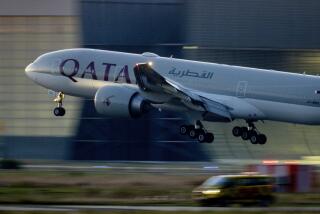Medical Emergency at 40,000 Feet
- Share via
Last month’s $2.7-million judgment against Lufthansa Airlines--awarded to a passenger because the pilot of a 10-hour Miami-to-Frankfurt flight kept flying after the passenger had had a heart attack--has sparked discussion about medical emergency procedures aloft.
Are available medical techniques sophisticated enough? Are enough doctors available? Is equipment modern and useful? Opinions vary, but the airline industry claims, particularly on flights within the United States, that passengers are well protected.
Crises such as the one aboard the Lufthansa flight are uncommon, according to airline officials who emphasize that emergency medical procedures aloft are constantly being reevaluated. For example, the Airline Transport Assn., an industry group that represents major U.S. carriers, is polling its members about their emergency medical policies. (Conclusions are not expected until later this year.)
Many decisions are made on a case-by-case basis. Emergency landings for medical reasons are left to the discretion of the captain, said Curtis Austin, spokesman for the Federal Aviation Administration. Since 1990, the FAA has received five reports of unscheduled landings stemming from medical emergencies aloft.
If statistics are any indication, the system appears to be working. The in-flight death rate is low--about 25 for every million departures, according to Dr. Robert R. Orford, a Mayo Clinic physician and joint medical director for Northwest Airlines, citing reports in medical literature. More than one-half are related to cardiac problems.
In a study of 120 airlines, conducted from 1977 to 1984 and published in the Journal of the American Medical Assn. in 1988, there were 577 in-flight deaths, or about 72 a year. Most individuals who died reportedly did not have health problems before travel. About 63% of the deaths were due to sudden and unexpected cardiac problems. Most likely to die were middle-age men.
The U.S. government does regulate some aspects of emergency care, however.
Under FAA regulations, which apply only to U.S. airlines, flight crew members must have first-aid training. Each aircraft must also carry an approved first-aid kit with a blood pressure monitor, stethoscope, devices to open respiratory passages, syringes, needles, dextrose solution, epinephrine, nitroglycerin and allergy medicine.
Many airlines exceed FAA regulations, according to industry sources.
Qantas Airways, for example, keeps a physician on call, although not required to by the FAA. Qantas also carries the required medical kits, as well as defibrillators (devices used to restore normal heart rhythm) on all international flights, said a spokeswoman. Qantas flight service directors are trained in defibrillator use. From 1991 to late ‘94, defibrillators were used 50 times. In 1994, there were nine deaths on 30 million flights, she added. All were cardiac related. The decision to carry defibrillators was made partly because the average flight time is long: seven hours.
Some airlines maintain a network of physicians who remain on call in case medical advice is needed quickly.
British Airways keeps a physician on call 24 hours a day, said spokesman Sandy Gardiner. In 1995, there were 2,100 medical emergencies aloft, Gardiner said.
Lufthansa maintains 15 physicians on call around the clock, said spokesman Dan Lewis. And American Airlines keeps a physician on call at all times, according to a spokesman.
Southwest maintains access to a physicians through a contract service, said spokeswoman Linda Rutherford, pointing out that Southwest passengers are usually close to community hospitals because the average flight is only an hour.
Since late 1994, Northwest Airlines has used a 24-hour consulting service offered by the Mayo Clinic, Orford said. Last year it logged 268 calls. In a typical call, he said, airline officials describe a medical emergency in progress and ask whether a plane en route should land or if the passenger should be treated on board.
The ATA poll of its 20 U.S. members, begun in late 1995, was not sparked by the Lufthansa judgment, said ATA spokesman Tim Neale. (A Lufthansa spokesman said the judgment is being appealed.) “What we are trying to do is get a picture of what kind of emergencies are occurring,” Neale said.
After assessing the nature of the emergencies, the next question, Neale said, is “Are we prepared?”
The FAA’s list of unscheduled landings prompted by medical emergencies during the past two decades shows the reasons vary from heart attack to on-board mishaps. One flight landed when a flight attendant crushed a ring on her finger; another when an elderly passenger had difficulty breathing. One flight turned back when a briefcase fell from an overhead storage bin and injured a passenger.
When medical emergencies occur on a commercial flight, chances are good that a physician will be nearby. “In about 80% of cases, there will be medical personnel on board,” said the ATA’s Neale, based on information from the membership.
On one Los Angeles-to-Hawaii flight last year, there were five doctors on board when a man became seriously ill, a Qantas spokeswoman said. They all agreed that the flight should turn back, and it did. Today, the man is alive and well.
Others find the 80% figure high. A medical professional was found for just 25% of medical emergencies on British Airways last year, Gardiner said.
Medical emergencies aloft are more an international problem than a domestic one, said Marty Salfen of the International Airline Passengers Assn., a Texas-based organization representing 400,000 travelers worldwide. “Most domestic flights are within 20 or 30 minutes of an airport,” he said.
The Healthy Traveler appears the second and fourth week of every month.
More to Read
Inside the business of entertainment
The Wide Shot brings you news, analysis and insights on everything from streaming wars to production — and what it all means for the future.
You may occasionally receive promotional content from the Los Angeles Times.










